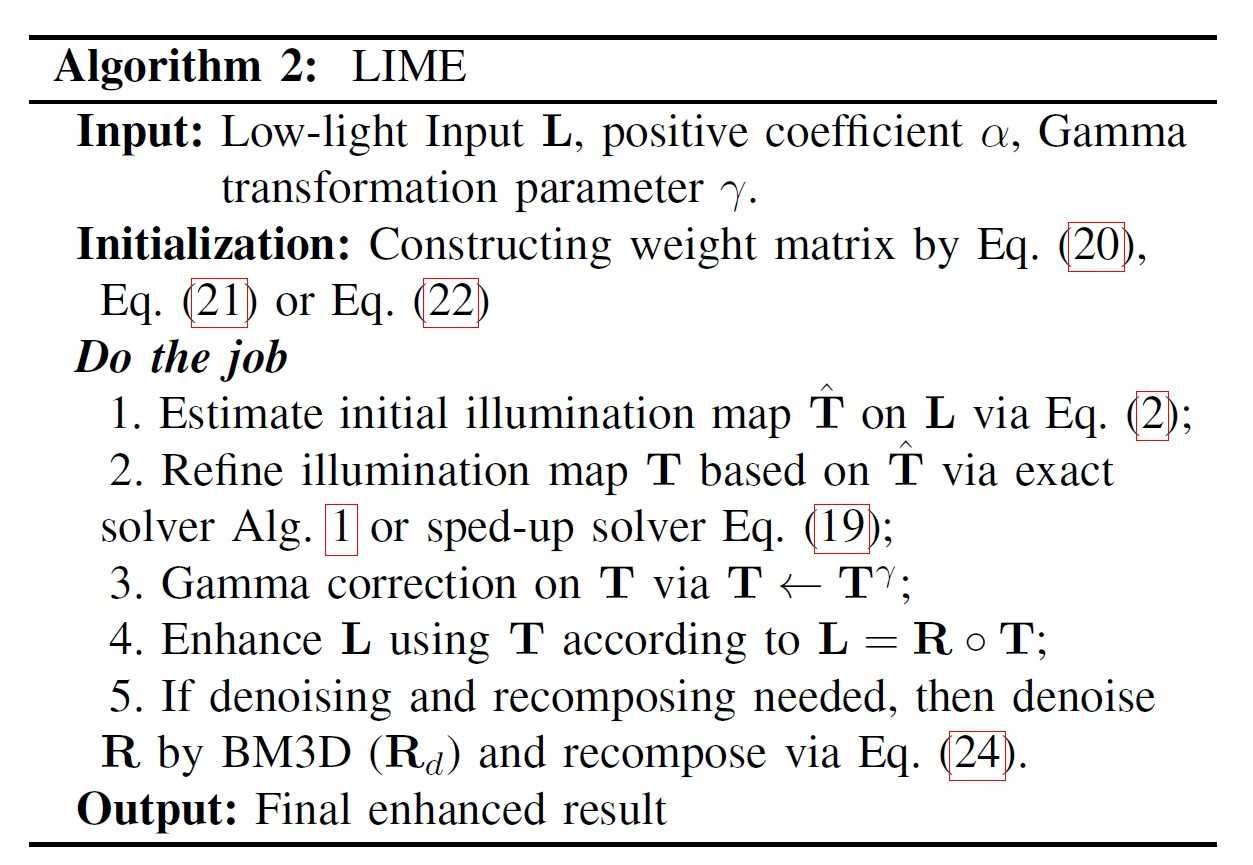标签:diff paper layer func like effect strong splay algorithm
目录
Retinex theory In this paper, A method enhancing low-light image illumination quality by improve illumination layer based on retinex theory is proposed. As mentioned in retinex theory, a image can be composed into reflectance layer and illumination layer, and can be recovered by the element-size multiplication of them.
\[S^c = I \odot R^c\quad c\in\{R, G, B\} \tag{1}\]
\(Eq.1\) where \(S\) is a image stored in RGB mode, \(I\) and \(R\) are illumination map and reflectance map respectively. A prior assumption that layers in RGB image have the common illumination map is established in this work.
initial estimation Many classic method can be applied to this process, maximum RGB channel image, grayscale image are available, de-haze method. Maximum RGB channel image is applied in this work for its low time complexity and outstand visual effects in extensive experiments.
\[\hat{T}(x) \larr \max_c L^c(x)\quad c\in\{R, G, B\}\tag{2}\]
Reflectance map \(R\) can be obtained by approaches based on retinex theory.
\[R(x) = \frac{L(x)}{\hat{T}(x) + \epsilon}\tag{3}\]
\(Eq.3\) is a transformation of \(Eq.1\), where \(\epsilon\) is a very small constant parameter to avoid the zero denominator.
Another approach based on the observation that inverted low-lighted images look similar to haze image mentioned in original paper which estimate the transmission map for dehazing based on the dark channel prior theory, but is rejected by the author for its less perfect performance on dark details.
\[1- L = (1 - R)\odot\hat{T} + \alpha(1 - \hat{T})\]
\[\hat{T}(x) \larr 1 - min_c\frac{1 - L^c(x)}{\alpha} = 1 - \frac{1}{\alpha} + max_c\frac{L_c(x)}{\alpha}\]
\[R(x) = \frac{L(x) - a + \alpha}{(1 - \frac{1}{\alpha} + \max_c\frac{L^c(x)}{\alpha} + \epsilon)} + (1 - \alpha)\tag{4}\]
refinement Considering an significant illumination property that illumination is local-smooth, we add a formula to express the smoothness of illumination estimation to cost function.
\[\min_T||\hat{T} - T||^2_F + \alpha||W\circ\bigtriangledown T||_1\tag{5}\]
\(Eq.5\) \(T\) is the optimization goal of cost function \(Eq.5\), \(W\) is a weight matrix whose designed method will be described in next subsection, \(\bigtriangledown T\) is the first order derivative operator of T.
Illumination estimation problem turns into a optimization problem at last, Optimization algorithm is described in the original paper, ==which is too complex to understand for me==.
\[T^{t + 1}\larr \mathcal{F}^{-1}(\frac{\mathcal{F}(2\hat{T} + \mu^{(t)}D^{(t)}(G^{(t)}-\frac{Z^{(t)}}{\mu^{(t)}})}{1 + \mu^{(t)}\sum_{d\in{h, v}}\bar{\mathcal{F}(D_d)}\circ\mathcal{F}(D_d)})\tag{13}\]
\[\mathbf{G}^{(t+1)}=\mathcal{S}_{\frac{\alpha W}{\mu^{(t)}}}\left[\nabla \mathbf{T}^{(t+1)}+\frac{\mathbf{Z}^{(t)}}{\mu^{(t)}}\right]\tag{15}\]
\[\begin{array}{l}{\mathbf{Z}^{(t+1)} \leftarrow \mathbf{Z}^{(t)}+\mu^{(t)}\left(\nabla \mathbf{T}^{(t+1)}-\mathbf{G}^{(t+1)}\right)} \\ {\mu^{(t+1)} \leftarrow \mu^{(t)} \rho, \rho>1}\end{array}\tag{16}\]
\(W\) definition
Three methods are mentioned in this paper.
Strategy 1:
The same as \(l_2\) normal
\[W_h(x)\larr 1\\W_v(x)\larr 1\tag{20}\]
Strategy 2:
Set initial luminance as weight parameters:
\[\mathbf{W}_{h}(x) \leftarrow \frac{1}{\left|\nabla_{h} \hat{\mathbf{T}}(x)\right|+\epsilon} \\\mathbf{W}_{v}(x) \leftarrow \frac{1}{\left|\nabla_{v} \hat{\mathbf{T}}(x)\right|+\epsilon}\tag{21}\]
Strategy 3:
Inspired by Relative Total Variation(RTV), parameters is set via:
\[\begin{aligned}&\mathbf{W}_{h}(x) \leftarrow \sum_{y \in \Omega(x)} \frac{G_{\sigma}(x, y)}{\left|\sum_{y \in \Omega(x)} G_{\sigma}(x, y) \nabla_{h} \hat{\mathbf{T}}(y)\right|+\epsilon}\\&\mathbf{W}_{v}(x) \leftarrow \sum_{y \in \Omega(x)} \frac{G_{\sigma}(x, y)}{\left|\sum_{y \in \Omega(x)} G_{\sigma}(x, y) \nabla_{v} \hat{\mathbf{T}}(y)\right|\epsilon}\end{aligned}\tag{22}\]
1.2 illumination enhancement
Lots of method can be applied to enhancing illumination, such as HE based method, CLAHE based, sigmoid function and gamma correction.
gamma correction In this work, gamma correction is applied to enhance illumination map.
\[T\lArr T^\gamma\]
1.3 recover to origin format
As the retinex theory, recovering can be processed by:
\[L = R\circ T\]
1.4 sumup
Algorithm is defined as follow:

1.5 Moreover
denoising RM3D algorithm is referred in this paper, moreover I‘d like to try some other approaches to overcome this problem, such as bilateral filter/ guided filter.
lightness-aware refer to another paper
lightness-aware contrast enhancement for images with different illumination conditions
Is to be tidied.
paper reading(4) - LIME: Low-light Image Enhancement via Illumination Map Estimation
标签:diff paper layer func like effect strong splay algorithm
原文地址:https://www.cnblogs.com/litun/p/12233342.html